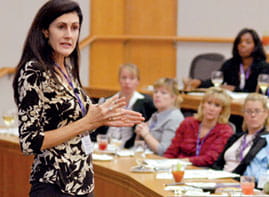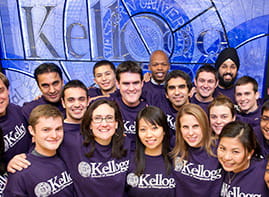Staking a claim in China
Strategies for winning in the Far Eastern market are explored at the Kellogg Greater China Business Conference
By Deborah L. Cohen2/17/2009 - When St. Louis-based Emerson began developing a presence in China in the late 1970s, there was no clear-cut formula for success. It was catch-as-catch-can in a new frontier, said Sara Yang Bosco, president of the company’s Asia Pacific division.
Few American corporations were authorized to do business in the country, and those that were could only interact with government-sanctioned Chinese companies, not necessarily the end users of their products.
Despite these challenges and others ranging from limited air travel to steep cultural and language barriers, the industrial engineering-and-technology company was willing to stake a claim on the promise of what proved to be a burgeoning and profitable market. Today, China represents roughly half of Emerson’s $4.5 billion in annual Asia Pacific sales and employs more than 35,000 workers.
“Pretty much we knew that China was someplace we had to be,” said Bosco, delivering the keynote address Feb. 14 at the 2009 Kellogg Greater China Business Conference. “Did we have goals? Sometimes we did and sometimes we didn’t — some of it was luck. Some of it was hard work by a very dedicated work force.”
Bosco’s speech was one of five events scheduled at the student-led conference, which addressed China’s current shift toward a role in innovation from one solely of production. It drew about 100 attendees, including current Kellogg students, faculty and interested parties from Chicago’s Asian business community.
Throughout the day, panelists from organizations as varied as the American Chamber of Commerce in China, Eaton Corp., venture capitalists and a host of start-ups covered topics ranging from marketing to investing and starting a business in the fast-growing Chinese economy.
Describing her company’s 30-year history in the China market, Bosco plotted a winding course not unlike that taken by other American multinationals, beginning with the early licensing of technology to the establishment of joint ventures and the formation of a wholly owned investment company.
Emerson’s latest tactic — making strategic acquisitions — represents another growing trend, one that has been made easier in recent years by less burdensome financial regulations by the Chinese government. Profitable ideas often come to the surface more quickly in China, where it is far easier to obtain patent approval for new technologies than in the United States, Bosco said. The company’s former general counsel for the Asia Pacific region, Bosco assumed her current post in January 2008.
“We are constantly looking at acquisitions,” she said, adding that Emerson “can buy companies to fill in gaps that we have in our product mix, in our technology mix, in our people mix, our distribution channel mix, etc.”
Acquisitions such as the company’s 2001 purchase of Avansys, China’s leading network power provider, are also helping Emerson achieve a goal for more homegrown innovation on the ground within the countries where it operates. The company, whose products range from industrial components to climate control systems and wireless technology, now operates more than 40 entities in China, including more than 30 wholly foreign-owned enterprises plus JVs and engineering centers.
“What’s driving IT, what’s driving innovation is not companies like ours,” said Bosco, a Chinese-American who was born and raised in the United States. “It’s really what going on in China with Chinese companies.”
To be sure, many hurdles remain, she said, noting that piracy of intellectual property remains a top concern for U.S. companies. Even so, the Chinese government has become increasingly stringent in enforcing the law.
“I think there is a preconception that China is backward — this horse and cart society,” she said, answering a student’s question about the biggest misconceptions by Americans. “That is definitely not true.”
Emerson’s financials are testament to the continued allure of international markets such as China. In fiscal 2008, the company’s international sales exceeded those in the United States for the second year in a row, representing 54 percent of total revenues of $24.8 billion.
“We’re now bigger in Asia than we are in the United States,” said Bosco. “China is one of the biggest players in the emerging markets. We really expect this number to increase.”






